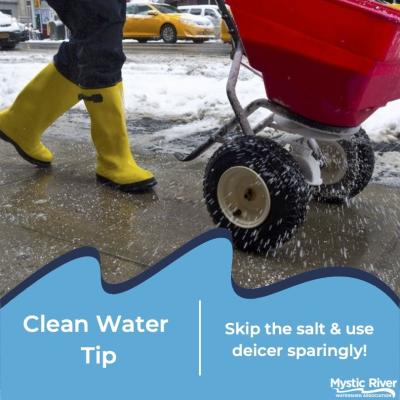Melrose Stormwater Management Program
The City of Melrose is implementing the attached Stormwater Management Program (SWMP) to improve the water quality of the City's ponds and streams, as well as downstream waterways. The SWMP is a living document that will be updated each time changes are deemed necessary, as well as each year to add our Stormwater Annual Report. These reports have been produced in compliance with the US Environmental Protection Agency's National Pollutant Discharge Elimination System (NPDES) permitting program. If you have any questions or comments on the document, please contact the Melrose Engineering Division at 781-979-4172 (publicworks@cityofmelrose.org). (View Program Report Here)
When considering local development, please review the following Massachusetts LOW IMPACT DEVELOPMENT TOOLKIT to reduce the environmental footprint of new growth.
Keep our rivers, lakes, ponds, and streams clean -- Use de-icer smartly and sparingly!
When the snow melts, do you ever wonder where all that salt and de-icer goes? You guessed it! It flows over our driveways, sidewalks, and roads, into the nearest catch basin, and directly (untreated!) into our waterways.

What’s wrong with salt and de-icer in our water?
SALT in our fresh water is not good for plants, wildlife, or people. Birds can mistake salt crystals for food, eating them and getting sick. Salt can be toxic to fish and others in aquatic systems. Salt is not good for our plants, and in many wetlands salt-tolerant invasives are crowding out our native vegetation, which then affects the wildlife that lose their food sources. And of course salt in our water supplies is not good for us -- we all know that salt is linked to high blood pressure and heart disease. Salt includes sodium chloride, as well as calcium and magnesium chloride.
Some use SAND, and while it doesn’t carry chemicals into our waterways, it does clog catch basins and cause flooding. It can also carry other pollutants into our waterways. If used, excess sand should be swept up.
DE-ICER is a preferable alternative to both salt and sand, but it is still not perfect, and should be used smartly and sparingly. De-icers include Sodium or Potassium Acetate and Calcium Magnesium Acetate.
What can YOU do to keep your pavement safe while also keeping your water clean?
- Use de-icer (sodium acetate, potassium acetate, and calcium magnesium acetate) instead of salt (sodium chloride, calcium chloride, and magnesium chloride).
- Shovel early and often. Remove as much snow and ice as you can, and only use de-icer on what you can’t take care of with a shovel.
- Follow product instructions and only use as much de-icer as you need. More is not better.
- For heavy snowfalls, shovel early and often to avoid the snow compacting and forming ice.
- For wet snow or sleet and freezing rain, apply de-icer product early on to prevent snow from bonding or ice from building up.
